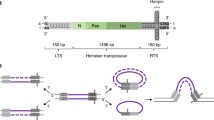Abstract
From a plasmid carrying the tnpA gene and one inverted repeat sequence (IR) of transposon Tn3, plasmids containing a structure characteristic of transposons, i.e., two IRs flanking a tnpA gene, were generated spontaneously in vivo. They appear to have arisen either through the formation of a “staggered” head-to-head dimer or by so-called one-ended transposition. These putative transposons could indeed transpose to, or form cointegrates with, a recipient plasmid. Based on these findings it is proposed that a primeval transposase gene and its target site evolved first, and subsequently gave rise to a “fully-fledged” transposon by head-to-head dimerization or one-ended transposition.
Similar content being viewed by others
Author information
Authors and Affiliations
Additional information
Received: 30 October 1998 / Accepted: 1 April 1999
Rights and permissions
About this article
Cite this article
Morita, M., Umemoto, A., Watanabe, H. et al. Generation of new transposons in vivo: an evolutionary role for the “staggered” head-to-head dimer and one-ended transposition. Mol Gen Genet 261, 953–957 (1999). https://doi.org/10.1007/PL00008636
Issue Date:
DOI: https://doi.org/10.1007/PL00008636




